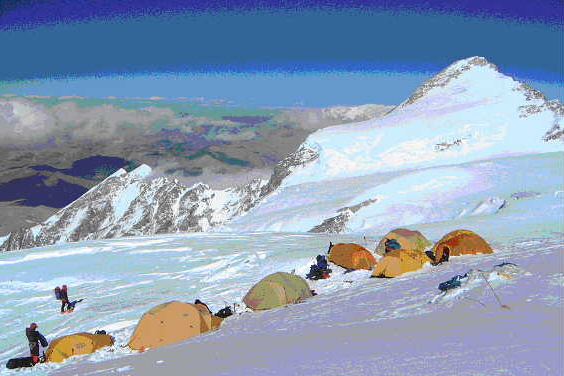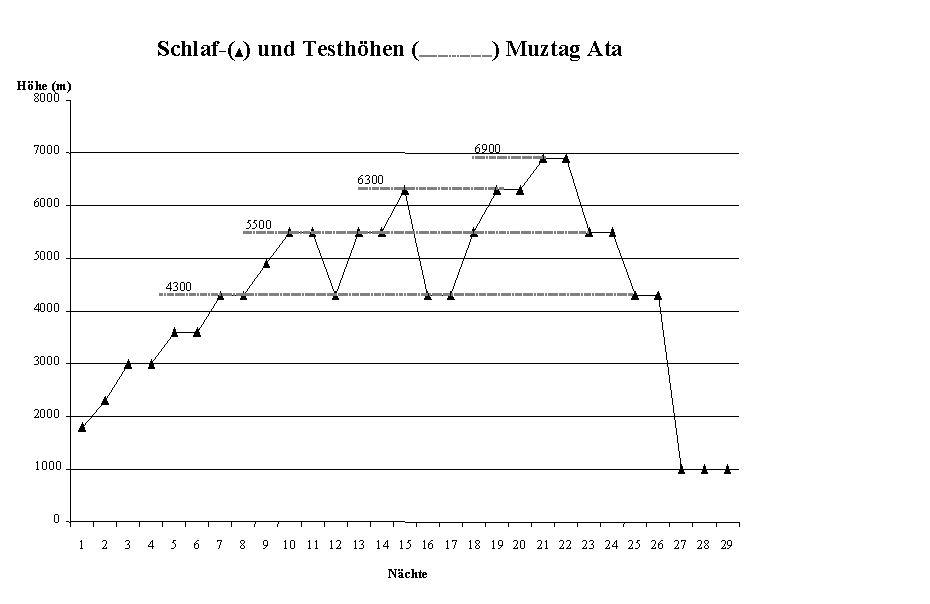The research program is supported by Pfizer Switzerland.
The effects on the brain due to exposure to extreme altitude and resulting lack of oxygen has been controversially debated ever since the first attempts to climb the world's highest mountains. The observed impairment of cerebral function at high altitudes is possibly caused by the low oxygen supply alone, but maybe other factors like the extreme physical and mental exhaustion also play a key role. The possibility of persistent cerebral impairment even after return to lower regions is not completely excluded. This study evaluates the cerebral functions by a series of adapted tests. We will perform different neuropsychological tests before, after and during the expedition. Computer assisted measuring of eye movements and hand-eye coordination will be part of the study as well as recording acoustic evoked brain currents.
The low oxygen supply at high altitudes requires a high ability of adaptation of breathing patterns at rest and during exercise. It is also very important that during sleep breathing is adequate to ensure a sufficient oxygen supply for recovery. An inadequate acclimatization induces lack of oxygen and causes high altitude related illnesses. Up to the present it was not possible to measure these adaptations during "real" activities of mountaineers in the terrain. A new light-weight portable monitoring system consisting of a snugly fitting body garment with built-in sensors allows us to measure depth and frequency of breaths, the oxygenation of the blood, the heart rate and other physiological data 24 hours a day. These measurements provide an new insight into the adaptation of breathing regulation and its influence on physical performance and the incidence of altitude related illnesses. Rest and activity patterns can be recorded during the entire expedition by an accelerometer placed at the wrist as an indirect measure of sleep and wakefulness in these extreme conditions.

Retinal haemorrhages are one manifestation of acute exposition to high altitude related hypoxia and can seriously impair sight especially if they affect the central region of the retina. The aetiology of these haemorrhages is still not entirely explained. Possible causes have been stated to be high intraocular pressure, non-acclimatization or an increased capillary fragility at high altitudes. It is not known if retinal bleeding is associated with other altitude related illnesses. A correlation between these two would be of great interest because retinal haemorrhages can easily be diagnosed. This would not only be of great importance for scientific aspects of the project, but also for the medical attendance of mountaineers in high altitudes. We will take photographs of the retina and measure the blood flow in retinal vessels with specialized equipment.
Rapid ascent and thus lack of time for adaptation has been postulated to be an important contributing factor for development of high altitude pulmonary edema (HAPE), acute mountain sickness (AMS) and high altitude cerebral edema (HACE). The physiologic response mechanisms to hypobaric hypoxia and especially the triggering factors for maladaptation, e.g. development of AMS are still not well understood. Most recently new cardiac body fluid regulatory hormones have been described. Further, it is known that endothelial factors and inflammatory mediators can disturb blood-vessel wall interface and contribute to vascular damage seen in AMS. We therefore will determine different Natriuretic Peptides (ANP, BNP, CNP), measure renal clearance (Cystatin C) and endothelial as well as proinflammatory mediators at different altitude levels. These results will be compared to clinical performance scores, physiologic parameters such as O2 saturation, blood pressure and pulse.
With this medical research expedition up to 7600 meters of altitude, we hope to gain insight into pathogenesis of the frequently occurring AMS using novel markers of body homeostasis.

To main page